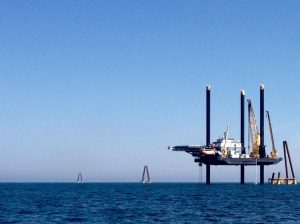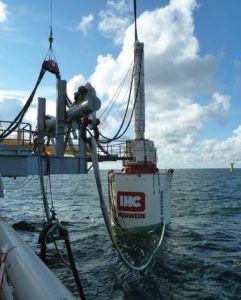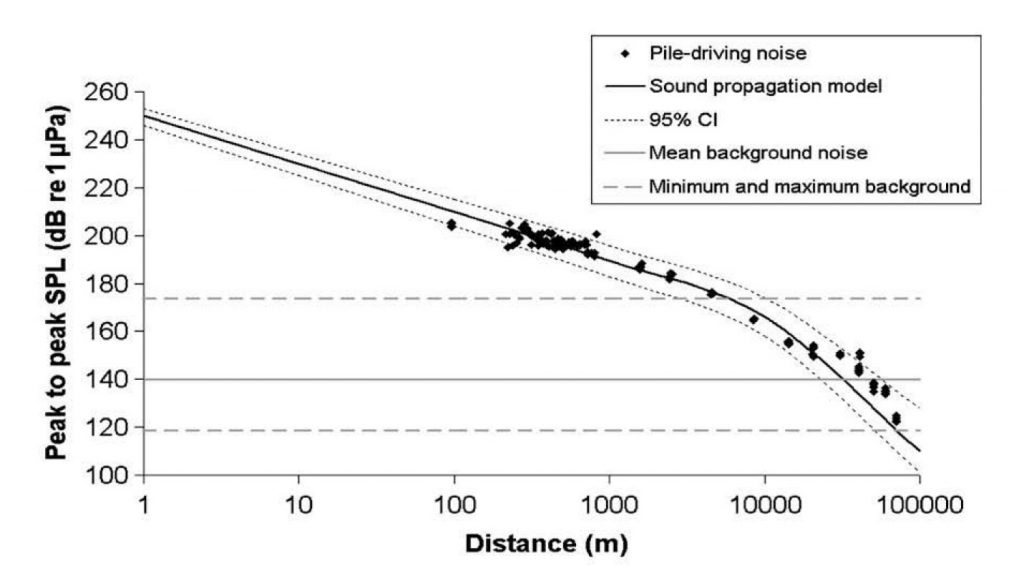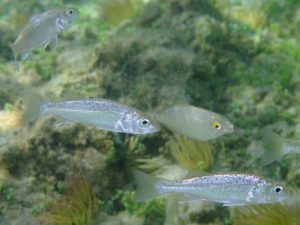Hate construction noise? Turns out marine animals aren’t fond of it either.
Written by Ian Jones

Sea cranes installing the foundation for a turbine at the Block Island Wind Farm – the first offshore wind farm in the U.S., completed in 2016. Photo source: Deepwater Wind.
Across the globe, humans continue to hammer giant steel piles into the ocean floor. Why? Such piles are necessary to support docks, piers, and variety of offshore energy platforms, from oil rigs to offshore wind farms. This pile driving activity adds an incredible amount of noise to the marine environment. It’s a loud, low frequency noise that propagates out in all directions from the source, both through the water and the ocean floor or seabed. This sound can be detected well above ambient noise levels many kilometers away [1]. Depending on how thick the piles are, how deep and rugged the ocean floor is (its bathymetry), and other factors, the sound levels from this activity can exceed 200 dB (in reference to 1 μPa) within 300 m/~1,000 feet of the source [2]. That’s far louder than sound levels recorded right next to jet airliners!

A giant hammer used for driving steel piles into the ocean floor. This hammer was used to construct the foundations of offshore wind turbines in the North Sea. Photo source: Dahl et al. 2015.
Given the expansion of offshore energy in the U.S. and many parts of the world, people are getting concerned about how exposure to this noise may adversely affect marine animals. Marine mammals, many fish, and even some invertebrates, detect and use sound to find food and mates, avoid predators, and communicate with each other. Accordingly, marine biologists and bio-acousticians (scientists that study how sound or acoustics are used by organisms) are working to figure out how this noise could impact the hearing, health, and behavior of a wide variety of marine organisms.
Characterizing these impacts is no small feat. Impacts on the health and ecology of a given species are dependent on a variety of factors, such as the animal’s hearing ability, how much sound reaches its surroundings, as well as its current behavioral state (e.g. whether it is mating or foraging), to name a few. In this post, I’d like to highlight a few of the major effects scientists have already found pile driving to have on marine mammals and fish, as well as some expected consequences.

Harbor porpoises (Phocoena phocoena). Photo by Bill Curtsinger, National Geographic Creative
One demonstrated impact of pile driving on the hearing of marine animals is a temporary threshold shifts. This means that an animals’ sensitivity to sound is temporarily lowered, potentially impairing its ability to detect other important acoustic cues. It’s similar to when you leave a loud concert and can’t hear well for a while. For example, lab experiments revealed that harbor porpoises exposed to pile driving noise for 6 hours had up to a 5 dB reduction in hearing sensitivity at a frequency of 8 kHz. As a comparison, 5 dB is roughly the difference in noise level between a refrigerator humming and a coffee maker percolating. The porpoises were able to recover from the shift within an hour after the exposure ended [3], however, this suggests pile driving noise, which overlaps in frequency with the vocalizations of many toothed whales and dolphins, has the potential to mask these critical social cues.

How far can pile driving noise travel? The measurements of noise level at various distances from the source are shown in black diamonds. The black line is a continuous estimate based on these measurements. As a comparison normal ambient noise levels are shown in grey. These measurements were taken near the installation of a wind farm northeast of Scotland. Even at 10,000 m (10 km) away from the construction site, pile driving noise was detected well above the ambient noise levels (solid grey). Figure source: Bailey et al. 2010.
Such physiological impacts are most likely to occur relatively close to pile driving sites, but effects on animal behavior may occur at much further distances. If construction areas overlap with animals’ feeding or mating grounds, individuals may avoid these areas if they perceive construction noise as threatening or otherwise distressing. A recent study on juvenile sea bass found that pile driving noise affected fish aggregation behavior by significantly reducing group cohesion [5]. Disrupting their group dynamics can make them more vulnerable to predators. In addition, fish exposed to sudden human-produced noise be desensitized and respond more slowly to real predation threats.
Beyond hearing threshold shifts and behavior changes, marine animals may also suffer injuries from pile driving noise. In one study, pile driving caused rupture and hemorrhaging of swim bladders (the organ that controls the buoyancy of fish) in hybrid striped bass. Fortunately, the injuries healed within 10 days [4], but this indicates repeated noise stress could lead to more severe injury and perhaps even death if fish remain in proximity to a construction site for a long time.

Juvenile seabass (Dicentrarchus labrax). Photo by Roberto Pillon, marinespecies.org.
We are only beginning to understand how exposure to offshore construction noise affects the health, behavior, and ecology of marine animals. While the expansion of renewable offshore energy platforms such as wind farms is important from an economic and environmental perspective, we must be mindful of the potential adverse noise impacts their construction has on animals inhabiting nearby waters. Continued research on these noise impacts is key to informing responsible management of marine construction activities in order to mitigate animals’ exposure to anthropogenic noise.
References
- Dahl, P., de Jong, C., & Popper, A. (2015). The Underwater Sound Field from Impact Pile Driving and Its Potential Effects on Marine Life. Acoustics Today, 11(2). Retrieved from http://acousticstoday.org/wp-content/uploads/2015/06/The-Underwater-Sound-Field-from-Impact-Pile-Driving-and-Its-Potential-Effects-on-Marine-Life-Peter-H.-Dahl-Christ-A.-F.-de-Jong-and-Arthur-N.-Popper.pdf
- Bailey, H., Senior, B., Simmons, D., Rusin, J., Picken, G., & Thompson, P. M. (2010). Assessing underwater noise levels during pile-driving at an offshore windfarm and its potential effects on marine mammals, 60, 888–897. https://doi.org/10.1016/j.marpolbul.2010.01.003
- Kastelein, R. A., Helder-Hoek, L., Covi, J., & Gransier, R. (2016). Pile driving playback sounds and temporary threshold shift in harbor porpoises (Phocoena phocoena): Effect of exposure duration. The Journal of the Acoustical Society of America, 139(5), 2842–2851. https://doi.org/10.1121/1.4948571
- Casper, B. M., Halvorsen, M. B., Matthews, F., Carlson, T. J., & Popper, A. N. (2013). Recovery of barotrauma injuries resulting from exposure to pile driving sound in two sizes of hybrid striped bass. PLoS ONE, 8(9), e73844. https://doi.org/10.1371/journal.pone.0073844
- Herbert-read, J. E., Kremer, L., Bruintjes, R., Radford, A. N., & Loannou, C. C. (2017). Anthropogenic noise pollution from pile-driving disrupts the structure and dynamics of fish shoals. Proceedings of the Royal Society B, 284. http://dx.doi.org/10.1098/rspb.2017.1627